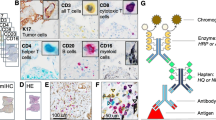Abstract
Multiplexed pathology imaging techniques allow spatially resolved analysis of cell phenotypes for interrogating disease biology. Existing methods for cell phenotyping in multiplex images require extensive annotation workload due to the need for fully supervised training. To overcome this challenge, we develop SANDI, a self-supervised-based pipeline that learns intrinsic similarities in unlabeled cell images to mitigate the requirement for expert supervision. The capability of SANDI to efficiently classify cells with minimal manual annotations is demonstrated through the analysis of 3 different multiplexed immunohistochemistry datasets. We show that in coupled with representations learnt by SANDI from unlabeled cell images, a linear Support Vector Machine classifier trained on 10 annotations per cell type yields a higher or comparable weighted F1-score to the supervised classifier trained on an average of about 300–1000 annotations per cell type. By striking a fine balance between minimal expert guidance and the power of deep learning to learn similarity within abundant data, SANDI presents new opportunities for efficient, large-scale learning for multiplexed imaging data.
Access this chapter
Tax calculation will be finalised at checkout
Purchases are for personal use only
Similar content being viewed by others
References
AbdulJabbar, K., et al.: Geospatial immune variability illuminates differential evolution of lung adenocarcinoma. Nat. Med. 1–9 (2020)
Bankhead, P., et al.: Qupath: open source software for digital pathology image analysis. Sci. Rep. 7(1), 1–7 (2017)
Bindea, G., et al.: Spatiotemporal dynamics of intratumoral immune cells reveal the immune landscape in human cancer. Immunity 39(4), 782–795 (2013)
Bromley, J., et al.: Signature verification using a “Siamese’’ time delay neural network. Int. J. Pattern Recognit. Artif. Intell. 07(04), 669–688 (1993)
Chang, C.C., Lin, C.J.: LIBSVM: a library for support vector machines. ACM Trans. Intell. Syst. Technol. 2(3) (2011). https://doi.org/10.1145/1961189.1961199
Chen, T., Kornblith, S., Norouzi, M., Hinton, G.: A simple framework for contrastive learning of visual representations (2020)
Ciga, O., Xu, T., Martel, A.L.: Self supervised contrastive learning for digital histopathology. Mach. Learn. Appl. 7, 100198 (2022)
Falk, T.: U-net: deep learning for cell counting, detection, and morphometry. Nat. Methods 16(1), 67–70 (2019)
Fassler, D.J., et al.: Deep learning-based image analysis methods for brightfield-acquired multiplex immunohistochemistry images. Diagn. Pathol. 15(1), 1–11 (2020)
Frénay, B., Verleysen, M.: Classification in the presence of label noise: a survey. IEEE Trans. Neural Netw. Learn. Syst. 25(5), 845–869 (2014)
Galon, J., et al.: Type, density, and location of immune cells within human colorectal tumors predict clinical outcome. Science 313(5795), 1960–1964 (2006)
Gerdes, M.J., et al.: Highly multiplexed single-cell analysis of formalin-fixed, paraffin-embedded cancer tissue. Proc. Natl. Acad. Sci. 110(29), 11982 LP–11987 (2013)
Giesen, C., et al.: Highly multiplexed imaging of tumor tissues with subcellular resolution by mass cytometry. Nat. Methods 11(4), 417–422 (2014)
He, K., Fan, H., Wu, Y., Xie, S., Girshick, R.: Momentum contrast for unsupervised visual representation learning. In: Proceedings of the IEEE Computer Society Conference on Computer Vision and Pattern Recognition, pp. 9726–9735 (2020)
Janowczyk, A., Zuo, R., Gilmore, H., Feldman, M., Madabhushi, A.: Histoqc: an open-source quality control tool for digital pathology slides. JCO Clin. Can. Inf. 3, 1–7 (2019)
Kobayashi, H., Cheveralls, K.C., Leonetti, M.D., Royer, L.A.: Self-Supervised Deep Learning Encodes High-Resolution Features of Protein Subcellular Localization. bioRxiv p. 2021.03.29.437595 (2022)
Koohbanani, N.A., Unnikrishnan, B., Khurram, S.A., Krishnaswamy, P., Rajpoot, N.: Self-path: self-supervision for classification of pathology images with limited annotations. IEEE Trans. Med. Imaging 40(10), 2845–2856 (2021)
Nalepa, J., Kawulok, M.: Selecting training sets for support vector machines: a review. Artif. Intell. Rev. 52(2), 857–900 (2019)
Sirinukunwattana, K., Raza, S.E., Tsang, Y.W., Snead, D.R., Cree, I.A., Rajpoot, N.M.: Locality sensitive deep learning for detection and classification of nuclei in routine colon cancer histology images. IEEE Trans. Med. Imaging 35(5), 1196–1206 (2016)
Tamborero, D., et al.: A pan-cancer landscape of interactions between solid tumors and infiltrating immune cell populations. Clin. Can. Res. 24(15), 3717–3728 (2018)
Tan, W.C.C., et al.: Overview of multiplex immunohistochemistry/immunofluorescence techniques in the era of cancer immunotherapy. Cancer Commun. 40(4), 135–153 (2020)
Taube, J.M., et al.: The society for immunotherapy of cancer statement on best practices for multiplex immunohistochemistry (IHC) and immunofluorescence (IF) staining and validation. J. ImmunoTher. Can. 8(1), e000155 (2020)
Tsyurmasto, P., Zabarankin, M., Uryasev, S.: Value-at-risk support vector machine: stability to outliers. J. Comb. Optim. 28(1), 218–232 (2014)
Author information
Authors and Affiliations
Corresponding author
Editor information
Editors and Affiliations
1 Electronic supplementary material
Below is the link to the electronic supplementary material.
Rights and permissions
Copyright information
© 2022 The Author(s), under exclusive license to Springer Nature Switzerland AG
About this paper
Cite this paper
Zhang, H. et al. (2022). Self-supervised Antigen Detection Artificial Intelligence (SANDI). In: Xu, X., Li, X., Mahapatra, D., Cheng, L., Petitjean, C., Fu, H. (eds) Resource-Efficient Medical Image Analysis. REMIA 2022. Lecture Notes in Computer Science, vol 13543. Springer, Cham. https://doi.org/10.1007/978-3-031-16876-5_2
Download citation
DOI: https://doi.org/10.1007/978-3-031-16876-5_2
Published:
Publisher Name: Springer, Cham
Print ISBN: 978-3-031-16875-8
Online ISBN: 978-3-031-16876-5
eBook Packages: Computer ScienceComputer Science (R0)





